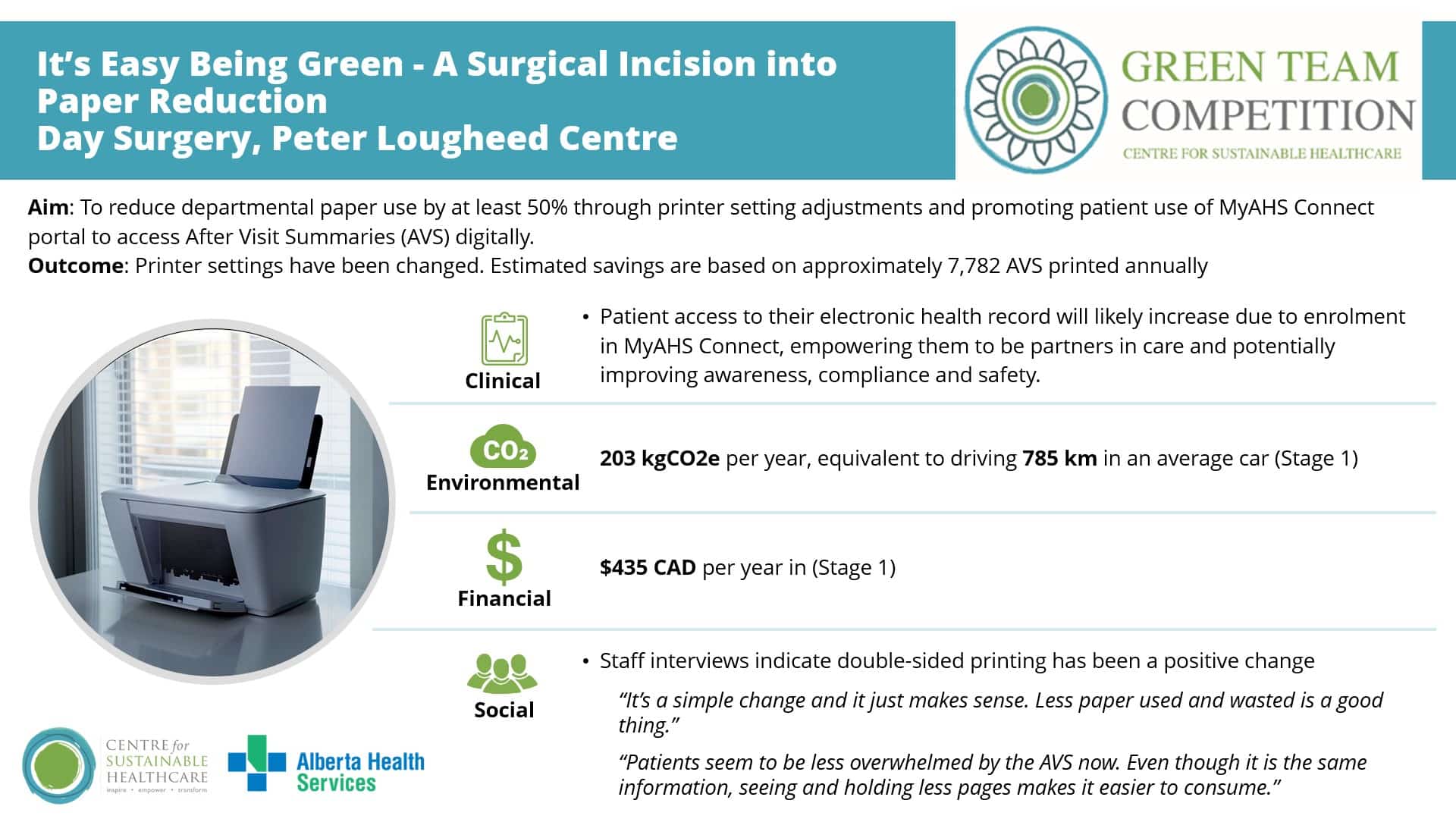Project completed as part of the Calgary Zone, Alberta Health Services Green Team Competition, 2025

Team members
- Stephen Caron – Patient Care Manager – PLC Women’s Health
- Katey Cha – Unit Manager (interim) – PLC Day Surgery and Surgical Short Stay
Setting: Day surgery department
Issue:
The Day Surgery Department printed over 70,000 single-sided pages per year for discharge instructions in the form of After Visit Summaries (AVS) across 7,782 patient visits. Each AVS averaged 9 pages, highlighting a significant environmental and operational burden. Despite the availability of electronic access via MyAHS Connect, which is already a well-established and safe electronic portal for patients to access their information, most patients still received printed copies, prompting the idea to reduce paper usage and shift toward digital delivery.
Intervention:
Aim: To reduce departmental paper use by at least 50% through printer setting adjustments and promoting patient use of MyAHS Connect portal to access After Visit Summaries (AVS) digitally.
The team identified a three-stage plan:
Stage 1: Default printer settings were changed to print on both sides of the paper.
Stage 2: Clerical staff in PAC were educated on how to teach the benefits of the online system and encouraged patients to sign up for MyAHS Connect online. Activation emails were sent to all PAC patients during the booking process, unless the patient refused.
Stage 3 (Future work): Decrease the number of AVS printed and provided in Day Surgery at discharge. Complete teaching at the bedside using Workstation on Wheels (WOW) or iPad and ask patients to access MyAHS Connect to view AVS/discharge instructions.
Outcomes:
Clinical:
Patient access to their electronic health record will likely increase due to enrolment in MyAHS Connect, empowering them to be partners in care and potentially improving awareness, compliance and safety.
Environmental:
- Double sided printing will save approximately 31,127 pieces of paper a year, an estimated 203.26 kgCO2e saved per year from AVS alone. This is equivalent to driving 785 km in an average car. This number is likely an underestimation of total impact since double-sided settings were applied to all printed documents in the department.
- Stage 2 and 3 changes will save 0.02788kgCO2e/patient with a potential to also decrease OR cancellation rates. More time is required to collect data.
Financial
- $435 per year (based on above 31,127 pieces of paper a year).
- Stage 2 and 3 changes require more time to collect data.
Social
- Staff interviews indicate double-sided printing has been a positive change
“It’s a simple change and it just makes sense. Less paper used and wasted is a good thing.”
“Patients seem to be less overwhelmed by the AVS now. Even though it is the same information, seeing and holding less pages makes it easier to consume.”
Before education and project launch, there were 3 activation attempt emails sent in the month of May by the PAC team. This increased to 180 activation emails sent between June 5 – July 18.
Key learning point
The shift to double-sided printing led to immediate reductions in paper use and supply costs and was widely accepted by staff and patients, demonstrating that small changes can have a meaningful and lasting impact, and using the established technology and resources effectively can have great potential.
Broader organizational support for sustainability was described as reassuring to the team. Knowing that AHS is actively pursuing sustainable healthcare practices reinforces the value of this work.
Please log in or sign up to comment.